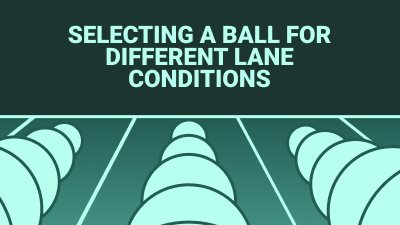Bowling enthusiasts know that the key to success lies not only in skillful technique but also in choosing the right equipment, particularly the bowling ball. The oil conditions of the lanes can significantly impact the performance of your ball. With the diverse array of Storm Bowling Balls available, selecting the perfect one for different lane conditions can be daunting. However, understanding the nuances of lane conditions and matching them with the appropriate ball can greatly enhance your game. Let’s look into the strategies for selecting the ideal Storm Bowling Ball for various lane scenarios.
Assessing Fresh Lane Conditions
Freshly oiled lanes present a unique challenge as there is ample oil on the surface. To combat this, bowlers typically choose bowling balls with strong hook potential and aggressive coverstocks. However, it's crucial to consider the volume of oil on the lane. If the oil volume is relatively light, despite being a fresh condition, selecting a ball with moderate hook potential might be more effective. Conversely, if the oil volume is heavy, a highly aggressive ball is warranted. The key is to match the ball's hook potential with the oil volume to achieve optimal traction without sacrificing control.
Navigating the Oil Transition
As the game progresses and bowlers make repeated shots, the oil on the lanes undergoes a transition, affecting ball reaction. During the oil transition phase, versatility becomes paramount. Medium-hook potential balls with versatile coverstocks are recommended as they can adapt to changing lane conditions. Additionally, paying attention to the ball's reaction as it moves through the front and middle parts of the lane can help in making necessary adjustments. It's advisable to monitor the ball's breakpoint and adjust your target accordingly to maintain consistency.
Conquering the Burn
The burn phase occurs when the oil on the lanes dissipates, resulting in more hook from increased friction. In such conditions, a ball with a cleaner reaction and less aggressive coverstock is preferable. The objective is to increase the ball's skid and control the hook without overreaction. Medium to low hook potential balls with smooth surfaces excel in navigating the burn phase. By minimizing hook potential, these balls offer a more predictable trajectory, allowing for precise targeting.
Tailoring Ball Selection to Oil Volume
In addition to considering the stage of lane conditions, assessing the volume of oil is crucial in selecting the right Storm Bowling Ball. A lane with heavy oil volume demands a ball with high hook potential and aggressive coverstock to create ample friction and hook. Conversely, lighter oil volumes require balls with moderate to low hook potential to prevent early hooking and maintain control. It's essential to match the ball's characteristics with the oil volume to optimize performance.
Identifying Ball Characteristics: Strong Hook Potential and Aggressive Coverstocks
1. Definition:
- Hook Potential: The ability of a bowling ball to curve or hook as it moves down the lane, affecting its trajectory on the lane and towards the pins.
- Aggressive Coverstocks: Refers to the outer surface of the bowling ball, designed to generate significant traction and hook potential by quickly gripping the lane surface.
2. Determining Hook Potential:
- Core Design: Asymmetrical cores typically offer higher hook potential due to their dynamic motion down the lane.
- Coverstock Material: Reactive resin coverstocks provide strong traction, resulting in higher hook potential compared to urethane coverstocks.
- Surface Texture: Rougher surface textures increase friction with the lane, leading to greater hook potential.
- Drilling Layout: Different layouts can alter a ball's hook potential by affecting its track flare and how the ball releases its energy
- Manufacturer Specifications: Storm Products provide information about a ball's hook potential and performance characteristics for reference.
3. Identifying Hook Potential:
- Surface Texture:A rougher surface texture may indicate higher hook potential. Look for bowling balls with visibly textured surfaces rather than smooth ones.
- Weight Block Shape: While this might require some basic understanding, asymmetrical weight blocks inside the ball can signify higher hook potential compared to symmetrical ones. Asymmetrical weight blocks often have irregular shapes rather than being round and even on its sides.
- Manufacturer Information: Check for any information provided by the manufacturer or on the ball's packaging. Some manufacturers might indicate the ball's intended use, including its hook potential.
Reading The Lanes
Selecting the perfect Storm Bowling Ball for different lane conditions involves a combination of factors, including the stage of lane conditions, oil volume, and ball characteristics. By understanding these variables and making informed decisions, bowlers can adapt their strategy and equipment to maximize their potential on the lanes. Whether facing fresh lane conditions, navigating the oil transition, or conquering the burn, choosing the right ball can make all the difference in achieving success.
